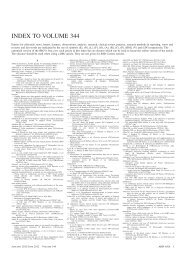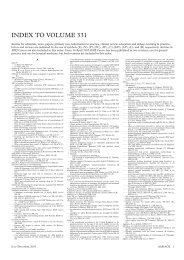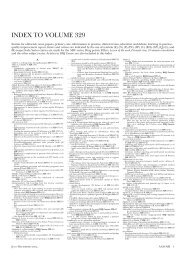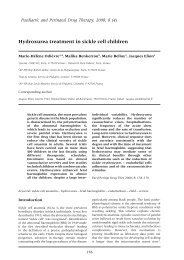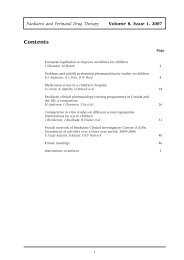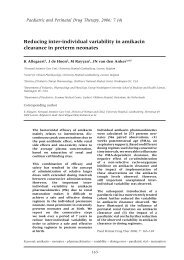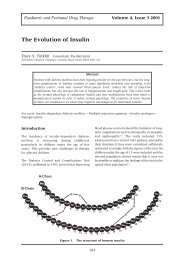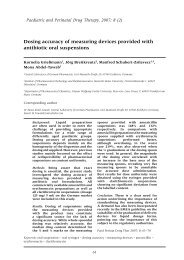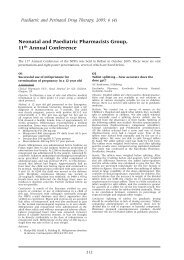Continuous Intravenous Infusion of Omeprazole in the Management ...
Continuous Intravenous Infusion of Omeprazole in the Management ...
Continuous Intravenous Infusion of Omeprazole in the Management ...
Create successful ePaper yourself
Turn your PDF publications into a flip-book with our unique Google optimized e-Paper software.
Paediatric and Per<strong>in</strong>atal Drug Therapy, 2003; 5 (4)<br />
<strong>Cont<strong>in</strong>uous</strong> <strong>Intravenous</strong> <strong>Infusion</strong> <strong>of</strong> <strong>Omeprazole</strong><br />
<strong>in</strong> <strong>the</strong> <strong>Management</strong> <strong>of</strong> an Upper Gastro<strong>in</strong>test<strong>in</strong>al<br />
Bleed <strong>in</strong> an Infant<br />
CS Ashtekar, H Vyas, R J Stewart, C Newman<br />
Paediatric Intensive Care Unit, University Hospital Nott<strong>in</strong>gham<br />
Correspond<strong>in</strong>g Author<br />
Dr H Vyas, Paediatric Intensive Care Unit, University Hospital Nott<strong>in</strong>gham, Queen’s Medical Centre, Nott<strong>in</strong>gham,<br />
NG7 2UH, UK EMail: harish.vyas@mail.qmcuh-tr.trent.nhs.uk<br />
We report a 3 month old <strong>in</strong>fant who presented with an upper gastro<strong>in</strong>test<strong>in</strong>al<br />
bleed. His bleed<strong>in</strong>g was controlled <strong>in</strong>itially with a cont<strong>in</strong>uous <strong>in</strong>travenous<br />
<strong>in</strong>fusion <strong>of</strong> omeprazole. The child ultimately needed surgery 72 hours after<br />
start<strong>in</strong>g <strong>in</strong>travenous omeprazole, as <strong>the</strong>re was a small bleed<strong>in</strong>g vessel at <strong>the</strong><br />
base <strong>of</strong> a duodenal ulcer.<br />
Paed Per<strong>in</strong>atal Drug Ther 2003; 5: 210–211<br />
Keywords: Gastro<strong>in</strong>test<strong>in</strong>al – haemorrhage – omeprazole – <strong>in</strong>fant<br />
Introduction<br />
Newborn <strong>in</strong>fants treated <strong>in</strong> <strong>the</strong> <strong>in</strong>tensive care units<br />
have a high frequency <strong>of</strong> stress <strong>in</strong>duced gastric<br />
hemorrhage (20%) and gastric lesions (53%) 1 .<br />
Traditionally, <strong>in</strong>travenous ranitid<strong>in</strong>e is used <strong>in</strong> <strong>the</strong><br />
treatment <strong>of</strong> any gastro<strong>in</strong>test<strong>in</strong>al haemorrhage.<br />
In severe and unresponsive cases oral omeprazole<br />
has been used.<br />
<strong>Omeprazole</strong> <strong>in</strong>jection is not licensed for use <strong>in</strong><br />
children 2 as experience is limited and to our<br />
knowledge <strong>the</strong>re has been no report <strong>of</strong> cont<strong>in</strong>uous<br />
<strong>in</strong>travenous <strong>in</strong>fusion <strong>in</strong> children. We report <strong>the</strong><br />
use <strong>of</strong> omeprazole as a cont<strong>in</strong>uous <strong>in</strong>fusion <strong>in</strong><br />
<strong>the</strong> management <strong>of</strong> a severe upper gastro<strong>in</strong>test<strong>in</strong>al<br />
bleed <strong>in</strong> an <strong>in</strong>fant.<br />
Case Report<br />
A 3 month old baby boy was referred with a<br />
history <strong>of</strong> <strong>in</strong>termittent vomit<strong>in</strong>g for <strong>the</strong> previous<br />
6 weeks and failure to thrive. A barium meal<br />
done at <strong>the</strong> referr<strong>in</strong>g hospital showed a small<br />
slid<strong>in</strong>g hiatus hernia and free gastro-oesophageal<br />
reflux with reflux oesophagitis.<br />
210<br />
He was born prematurely (28 weeks) by emergency<br />
caesarean section for pre-eclampsia and required<br />
medical management <strong>of</strong> respiratory distress,<br />
necrotis<strong>in</strong>g enterocolitis and persistent ductus<br />
arteriosus plus surgery for a right <strong>in</strong>gu<strong>in</strong>al hernia.<br />
He was admitted to <strong>the</strong> paediatric <strong>in</strong>tensive care<br />
unit follow<strong>in</strong>g an acute episode <strong>of</strong> haematemesis<br />
and melaena. On admission his haemoglob<strong>in</strong> was<br />
3.4 g/dl, <strong>in</strong>ternational normalised ratio (INR) 1.55<br />
(normal range 0.8 – 1.2) and activated partial<br />
thromboplast<strong>in</strong> time (APTT) ratio <strong>of</strong> 1.02 (normal<br />
range 0.84 – 1.16). Electrolytes and liver function<br />
tests were with<strong>in</strong> normal limits. He was given a<br />
blood transfusion and was also started on<br />
<strong>in</strong>travenous ranitid<strong>in</strong>e (1 mg/kg four times a day).<br />
After a period <strong>of</strong> stabilisation he was taken to <strong>the</strong>atre<br />
for <strong>in</strong>sertion <strong>of</strong> a central l<strong>in</strong>e and an oesophagogastro-duodenoscopy,<br />
which showed oesophagitis,<br />
with two small heal<strong>in</strong>g lesions <strong>in</strong> <strong>the</strong> antrum <strong>of</strong> <strong>the</strong><br />
stomach and no blood. It was difficult to visualise<br />
<strong>the</strong> duodenum because <strong>of</strong> <strong>the</strong> small size <strong>of</strong> <strong>the</strong> child<br />
and <strong>the</strong>refore a gastrotomy and duodenoscopy were<br />
performed. There was no focal lesion seen ei<strong>the</strong>r<br />
<strong>in</strong> <strong>the</strong> duodenum or <strong>the</strong> ileum. A Nissen’s<br />
fundoplication was performed and <strong>the</strong> child<br />
transferred to paediatric <strong>in</strong>tensive care.
Twenty four hours later he was noticed to have<br />
fresh blood <strong>in</strong> his nasogastric tube with melaena<br />
while he was on <strong>the</strong> maximum dose <strong>of</strong> ranitid<strong>in</strong>e<br />
(1 mg/kg four times a day) and sucralfate (250<br />
mg six times a day). He was <strong>the</strong>refore started<br />
on omeprazole (Astra Zeneca) via his nasogastric<br />
tube at 1 mg/kg/day <strong>in</strong>itially and <strong>in</strong>creased to<br />
3 mg/kg/day. He cont<strong>in</strong>ued to have melaena and<br />
fresh blood from his nasogastric tube while on<br />
omeprazole for 36 hours.<br />
In view <strong>of</strong> <strong>the</strong> exceptional circumstances, a<br />
cont<strong>in</strong>uous <strong>in</strong>travenous <strong>in</strong>fusion <strong>of</strong> omeprazole<br />
at 150 microg/kg/hour was commenced (us<strong>in</strong>g<br />
<strong>the</strong> Losec® “<strong>in</strong>fusion” <strong>in</strong>jection preparation,<br />
replac<strong>in</strong>g <strong>the</strong> syr<strong>in</strong>ge every 12 hours). Us<strong>in</strong>g a<br />
surface area <strong>of</strong> 0.2 m 2 for this 2.6 kg child <strong>the</strong><br />
total dose over 24 hours was approximately 80<br />
mg/1.73 m 2 . A load<strong>in</strong>g dose <strong>of</strong> omeprazole as<br />
suggested <strong>in</strong> adult studies 3 was not considered<br />
due to lack <strong>of</strong> available data <strong>in</strong> children.<br />
The bleed was controlled 6 hours after start<strong>in</strong>g<br />
omeprazole <strong>in</strong>fusion and <strong>the</strong> gastric aspirate pH<br />
was ma<strong>in</strong>ta<strong>in</strong>ed >5. A gastric pH was not checked<br />
before start<strong>in</strong>g omeprazole. Follow<strong>in</strong>g two more<br />
days <strong>of</strong> <strong>in</strong>travenous omeprazole it was changed<br />
to oral <strong>the</strong>rapy at 3 mg/kg/day. Bleed<strong>in</strong>g restarted<br />
with<strong>in</strong> a few hours <strong>of</strong> stopp<strong>in</strong>g <strong>the</strong> <strong>in</strong>fusion. The<br />
<strong>in</strong>fusion was <strong>the</strong>refore restarted at double <strong>the</strong><br />
orig<strong>in</strong>al dose, i.e. 300 microg/kg/hour (equat<strong>in</strong>g<br />
to approximately 160 mg/1.73 m 2 per day). This<br />
higher than previously reported total daily dose 4<br />
was undertaken <strong>in</strong> a bid to stop <strong>the</strong> rebleed<br />
know<strong>in</strong>g that <strong>the</strong> <strong>in</strong>travenous formulation has<br />
been reported to be well tolerated <strong>in</strong> severe peptic<br />
disease <strong>in</strong> children, after be<strong>in</strong>g used for several<br />
weeks with no adverse reactions reported 5, 6 .<br />
Fur<strong>the</strong>r <strong>in</strong>vestigations <strong>in</strong>clud<strong>in</strong>g immunoglobul<strong>in</strong>s<br />
and RAST for cow’s milk prote<strong>in</strong> were normal.<br />
The bleed<strong>in</strong>g ceased over <strong>the</strong> next few hours.<br />
Unfortunately he had a fur<strong>the</strong>r large bleed and<br />
his haemoglob<strong>in</strong> dropped to 6.9 g/dl. Follow<strong>in</strong>g<br />
resuscitation a second laparotomy was performed<br />
and a bleed<strong>in</strong>g duodenal ulcer was found <strong>in</strong> <strong>the</strong><br />
posterior wall <strong>of</strong> <strong>the</strong> first part <strong>of</strong> <strong>the</strong> duodenum<br />
wall. This was corrected surgically. The dose <strong>of</strong><br />
omeprazole was decreased to 150 microg/kg/hour<br />
post operatively and converted to oral <strong>the</strong>rapy<br />
after three days. He rema<strong>in</strong>ed well on oral<br />
omeprazole and at discharge he was feed<strong>in</strong>g<br />
normally and ga<strong>in</strong><strong>in</strong>g weight.<br />
Discussion<br />
<strong>Omeprazole</strong>, a proton pump <strong>in</strong>hibitor suppresses<br />
gastric acid secretion by act<strong>in</strong>g selectively on <strong>the</strong><br />
H + K + pump <strong>of</strong> <strong>the</strong> gastric mucosa. In a previous<br />
study omeprazole was used for <strong>the</strong> treatment <strong>of</strong><br />
Paediatric and Per<strong>in</strong>atal Drug Therapy, 2003; 5 (4)<br />
211<br />
peptic ulcer disease <strong>in</strong> pregnancy from conception<br />
and cont<strong>in</strong>ued un<strong>in</strong>terrupted until delivery 7 . No<br />
side effects or malformations were observed <strong>in</strong> <strong>the</strong><br />
newborns and follow up <strong>of</strong> <strong>the</strong>se children between<br />
2 and 12 years showed normal development.<br />
<strong>Intravenous</strong> omeprazole is effective and well<br />
tolerated <strong>in</strong> severe ranitid<strong>in</strong>e resistant peptic disease<br />
<strong>in</strong> children 5 and has previously been given to<br />
children at doses <strong>of</strong> 18 – 70 mg/1.73 m 2 12 hourly 4 .<br />
A dose <strong>of</strong> 40 mg/1.73 m 2 is required to ma<strong>in</strong>ta<strong>in</strong><br />
gastric pH above 4 6 . Agranulocytosis, haemolytic<br />
anaemia, rash, jaundice, elevated serum creat<strong>in</strong><strong>in</strong>e<br />
and serum transam<strong>in</strong>ase are some <strong>of</strong> <strong>the</strong> adverse<br />
reactions that can occur. However, <strong>in</strong> one child no<br />
adverse effects were reported even after 3 years<br />
<strong>of</strong> cont<strong>in</strong>uous treatment 8 . A cont<strong>in</strong>uous <strong>in</strong>fusion<br />
was preferred to separate <strong>in</strong>jections as a recent<br />
trial <strong>in</strong> adults showed that after endoscopic<br />
treatment <strong>of</strong> peptic ulcers, a high dose <strong>in</strong>fusion <strong>of</strong><br />
omeprazole reduced <strong>the</strong> rate <strong>of</strong> recurrent bleed<strong>in</strong>g<br />
and shortened <strong>the</strong> length <strong>of</strong> hospitalisation 3 . Our<br />
case demonstrates <strong>the</strong> safety and value <strong>of</strong><br />
omeprazole <strong>in</strong> <strong>the</strong> management <strong>of</strong> acute<br />
gastro<strong>in</strong>test<strong>in</strong>al bleed<strong>in</strong>g <strong>in</strong> an <strong>in</strong>fant. The need to<br />
always consider whe<strong>the</strong>r surgery is required was<br />
highlighted by <strong>the</strong> second major bleed.<br />
Conclusion<br />
<strong>Omeprazole</strong> can play a useful role <strong>in</strong> <strong>the</strong> medical<br />
management <strong>of</strong> acute gastro<strong>in</strong>test<strong>in</strong>al bleed<strong>in</strong>g <strong>in</strong><br />
an <strong>in</strong>fant alongside <strong>the</strong> need for surgery where<br />
necessary.<br />
References<br />
1. Kuusela AL, Maki M, Ruuska T, Laippala P. Stress<strong>in</strong>duced<br />
gastric f<strong>in</strong>d<strong>in</strong>gs <strong>in</strong> critically ill newborn<br />
<strong>in</strong>fants: frequency and risk factors. Intens Care<br />
Med 2000;26: 1501-1506.<br />
2. Losec <strong>Infusion</strong> 40mg SmPC. ABPI: Medic<strong>in</strong>es<br />
Compendium 2002, London: Datapharm<br />
Communications Ltd<br />
3. Lau JYW, Sung JJY, Lee KKC et al. Effect <strong>of</strong><br />
<strong>in</strong>travenous omeprazole on recurrent bleed<strong>in</strong>g<br />
after endoscopic treatment <strong>of</strong> bleed<strong>in</strong>g peptic<br />
ulcers. NEJM 2000;343:310-316.<br />
4. Jacqz-Aigra<strong>in</strong> E, Bellaich M, Faure C et al.<br />
Pharmacok<strong>in</strong>etics <strong>of</strong> <strong>in</strong>travenous omeprazole <strong>in</strong><br />
children. Eur J Cl<strong>in</strong> Pharmacol 1994;47:181-185.<br />
5. Faure C, Jacqz-Aigra<strong>in</strong> E, Bellaich M et al. IV<br />
omeprazole <strong>in</strong> children: effectiveness and<br />
pharmacology. Gastroenterology 1994;106:A76.<br />
6. Faure C, Michaud L, Shaghaghi EKet al. <strong>Intravenous</strong><br />
omeprazole <strong>in</strong> children: pharmacok<strong>in</strong>etics and effect<br />
on 24-hour <strong>in</strong>tragastric pH. J Pediatr Gastroenterol<br />
Nutr 2001;33:144-148.<br />
7. Brunner G, Meyer H, Athmann C. <strong>Omeprazole</strong> for<br />
peptic ulcer disease <strong>in</strong> pregnancy. Digestion<br />
1998;59: 651-654.<br />
8. De Giacomo C, Fiocca R, Villani L et al. <strong>Omeprazole</strong><br />
treatment <strong>of</strong> severe peptic disease associated with<br />
antral G cell hyperfunction and hyperpeps<strong>in</strong>ogenemia<br />
1 <strong>in</strong> an <strong>in</strong>fant. J Pediatrics 1990;117:989-993.




